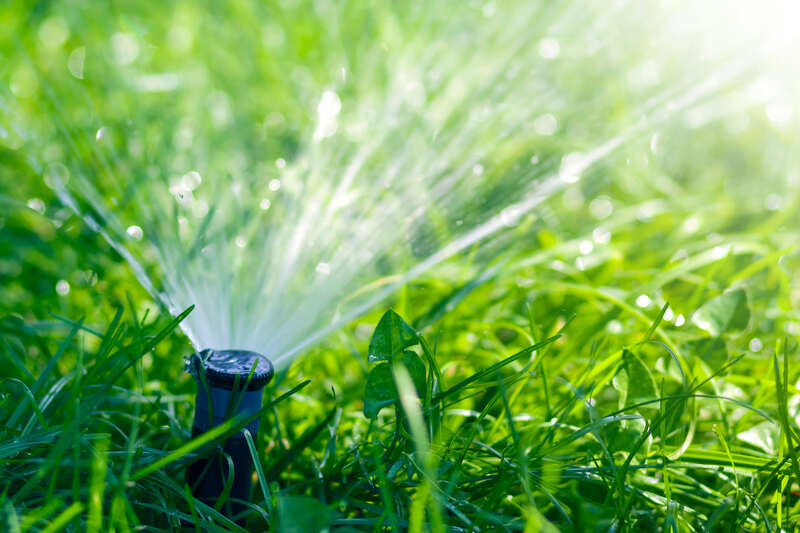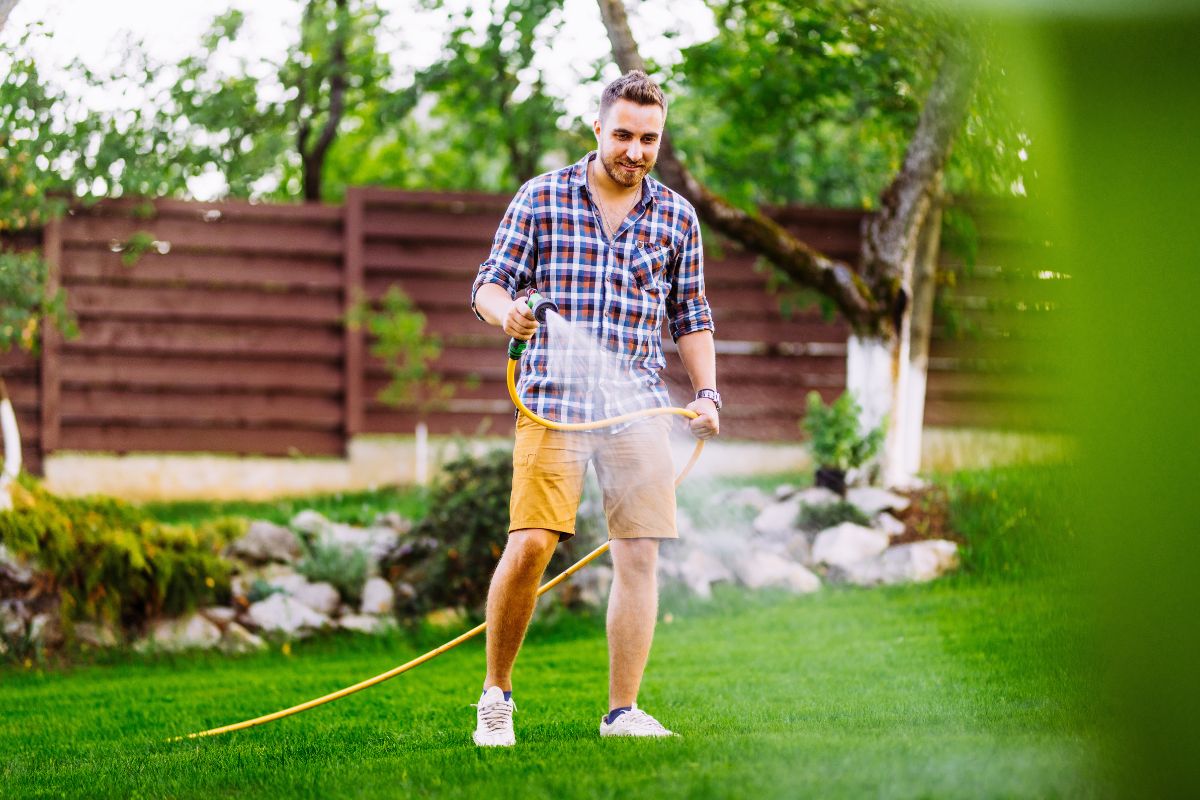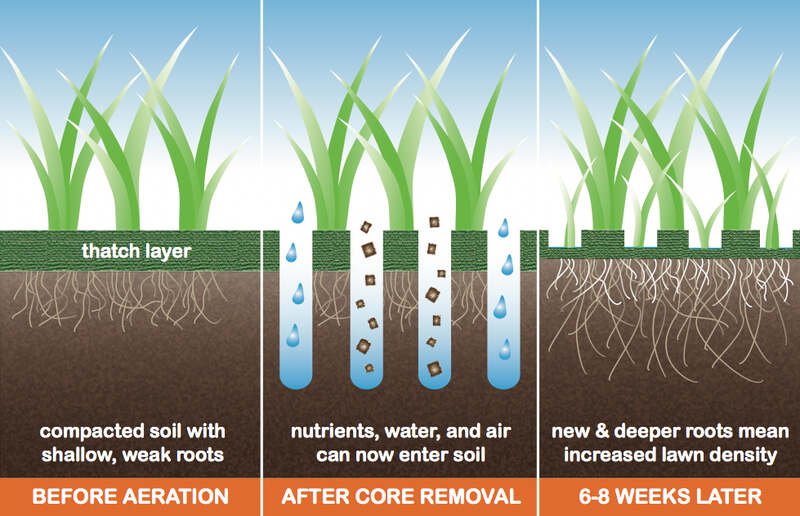
Summer in Austin feels like an endless heatwave, but that doesn’t have to mean an endless waste of water. By now, Austinites are pretty familiar with citywide water restrictions implemented to help conserve water during drought periods.
So, how can you stay mindful of your lawn’s water use without ruining your grass? We have 8 lawn watering tips to help you out.
- 1. Water in Early Morning
- 2. How Much Water? 1 Inch or 1.5 Inches Weekly
- 3. Choose Deep Watering Over Shallow Sprinklings
- 4. Check Your Irrigation System
- 5. Check Sprinkler Heads
- 6. Add Topdressing for Moisture Retention
- 7. Aerate Your Lawn Regularly
- 8. Mulch Your Grass Clippings
- More Watering Tips from Austin-Area LawnStarter Pros
- City of Austin Watering Restrictions
- FAQ About Lawn Watering in Austin
1. Water in Early Morning
Water in the early morning to reduce evaporation, says Austin Pro Isabel Lopez of AR Lawn Care in Georgetown.
The ideal time to water your lawn since is early in the morning, before 10 a.m., as temperatures and wind speeds are lower. That’s when water is most likely to be absorbed into the soil and less likely to evaporate or blow away without ever reaching your grass.
As a general rule, it’s best to water your lawn no more than once a week. During spring and fall, your grass can go up to two weeks between waterings.
See Related:
— Best Time to Water Your Lawn
— How Often Should I Water My Lawn?
2. How Much Water? 1 Inch or 1.5 Inches Weekly

Be mindful of how much water you’re using to prevent waste and harmful overwatering. No more than 1 inch of water per week is a good rule of thumb – and that includes rainfall.
Usually, a good soaking of an inch is enough. However, depending on your Austin grass type, you may go up to 1.5 inches. For instance, a Bermudagrass lawn needs 1.5 inches during a typical summer week, and Zoysiagrass and Buffalograss need only 1 inch.
See Related:
— 8 Signs Your Lawn Needs Water
— When to Stop Watering Your Lawn
3. Choose Deep Watering Over Shallow Sprinklings
If you want your grass to be resilient enough to survive a scorching summer, its roots will need to dig deep into the soil. Watering deeply and infrequently will encourage the grass roots to grow deeper. Frequently watering with shallow pours can stunt growth and end up doing more harm than good.
Note that if you overwater your lawn, you may end up weakening the root system and depleting the precious oxygen that grass roots need to thrive and survive.
4. Check Your Irrigation System
Check your irrigation system in early spring to make sure there aren’t any leaking pipes or hoses that need repair. This way, you’ll double-check you’re getting the most bang for your water buck.
5. Check Sprinkler Heads
Check the alignment of your sprinkler heads regularly, particularly after you’ve mowed your lawn. Replace any broken or clogged parts to prevent water waste.
6. Add Topdressing for Moisture Retention
Austin’s soil types often are low in organic matter. This means the soil has a harder time holding on to moisture, meaning high temperatures and blaring sun can leave the soil dry as a bone.
To solve this, topdress your soil with an organic-rich compost or mulch to restore that essential moisture.
Note: Adding a bit of natural fertilizer to the mix is also a great way to increase your soil’s nutrient content and naturally boost its fertility. But choose a fertilizer with low nitrogen content, as too much nitrogen can make the grass grow faster and suck up more water.
See Related:
— Topdressing a Lawn: The Benefits and How to Do It
7. Aerate Your Lawn Regularly

At least once a year, aerate your lawn by puncturing 6-inch holes to help increase the soil’s water absorption. Aeration will also help prevent flooding and runoff, as well as letting the vital nutrients get down to the deep roots.
See Related:
— What is Aeration? [Video]
— When to Aerate Lawns in Texas
— How to Aerate a Lawn
8. Mulch Your Grass Clippings
Austin Pro Tip (from Isabel Lopez of AR Lawn Care in Georgetown): Leave grass clippings o the lawn to help retain moisture and add organic matter.
When you mow, mulch the grass clippings. Not only is this a great way to break down the clippings and return their nutrients to the soil quickly, but it’s also a natural way to reduce evaporation.
Note: Don’t smother your grass with clumps of clippings.
See Related:
— Reasons to Use Grass Clippings as Mulch
— Mulching vs. Bagging Clippings
More Watering Tips from Austin-Area LawnStarter Pros
Austin Pro Tip from Collin Byington of Collins Lawn Care and Services in Kyle: Keep grass get longer through the summer months to help preserve the soil moisture.
Austin Pro Tip from Kevin Robinson of Pristine Lawn Care in Kyle: Stick to your watering schedule.
Austin Pro Tip from Jorge Veloz of Veloz Lawn and Landscape in Georgetown: Make sure you cut it at a level that will not kill or stress the grass.
City of Austin Watering Restrictions
As of July 2025, Austin is in Stage 2 Drought Water Use Restrictions due to declining water levels in the city’s water supply sources, Lakes Travis and Buchanan. At this stage, residential and commercial customers are permitted 1 to 2 watering days per week, depending on the type of irrigation method used.
For detailed information about the current watering restrictions in Austin and surrounding areas and how you can maintain your lawn even during drought, see our helpful guide to Austin’s watering regulations.
FAQ About Lawn Watering in Austin
It depends on the grass type and your sprinkler system, but a good general rule is to run the sprinkler for 30 minutes or one hour max, one day a week. In the fall and winter months, you may need to water less.
The most common Austin grass types include:
• St. Augustinegrass
• Bermudagrass
• Zoysiagrass
Both are good options. Just make sure to avoid the noon to 6 p.m. window when the sun is at its strongest. Early morning and late evening are the best times to water your lawn in Austin.
If you have an automatic sprinkler system, you’ll want to use a timer-activated sprinkler that suits the area you want to water. Hose-end sprinklers are great for smaller gardens and single-family dwellings. Another option is the soaker hose, which works best for circular beds and vegetable gardens.
In addition to regular watering, aerating the soil and adding an organic-rich compost or mulch can make a big difference in the health of your lawn. Mowing regularly and mulching the clippings are also great ways to keep your grass looking lush and green.
Avoid common lawn care myths such as ignoring your lawn in winter, fertilizing only once per year, or trying cheap DIY aeration methods.
See Related:
— When to Fertilize Lawns in Texas
— Core Aeration vs. Spike Aeration: What’s the Difference?
Hire an Austin Lawn Care Pro to Help Your Grass Thrive
To keep your grass thriving, abide by Austin’s watering restrictions, water only in the early morning, and water deeply. For overall help with your lawn care, call on LawnStarter’s Austin lawn care pros. LawnStarter also has lawn care pros across the Austin metro area in Cedar Park, Kyle, Pfugerville, and Georgetown.
LawnStarter’s pros mow lawns, trim around trees and fences, and blow debris off sidewalks, driveways, and patios. But that’s just for starters. As a LawnStarter customer, you can hire Austin pros for landscaping, tree care, leaf removal, and around 20 other outdoor services.
Main Photo Credit: Photo bilanol / Adobe Stock Free / License